Honda Civic Service Manual: Left M/T Differential Oil Seal Replacement (R18Z1 M/T)
2191F4 LEFT

|
|
1.
|
Raise the vehicle on a lift, and make sure it is securely supported.
|
|
|
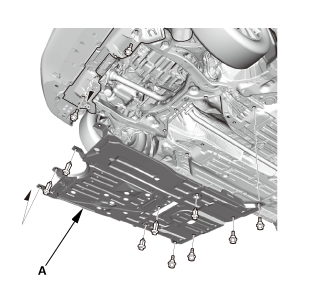
|
|
1.
|
Remove the engine undercover (A).
|
|
|
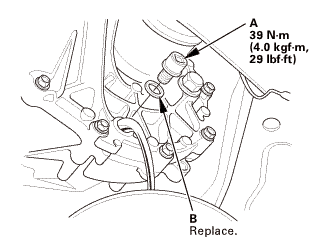
|
|
1.
|
Remove the drain plug (A) and the sealing washer (B), and drain
the MTF.
|
|
2.
|
Reinstall the drain plug with a new sealing washer.
|
|
|
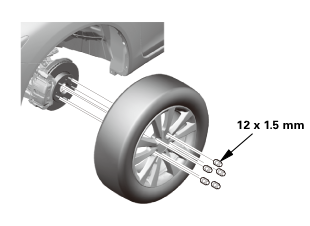
|
|
1.
|
Remove the left front wheel.
|
|
| 5. |
Lower Ball Joint Lower Arm Side - Disconnection |
|
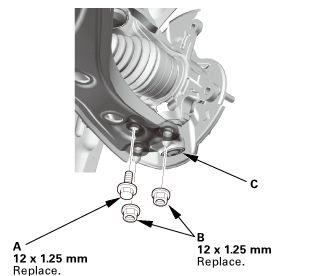 i225 i225
|
|
1.
|
Remove the flange bolt (A).
|
|
2.
|
Remove the flange nuts (B).
|
|
3.
|
Disconnect the lower ball joint (C) from the lower arm.
|
|
| 6. |
Driveshaft Front Left - Disconnection Inboard Side |
|
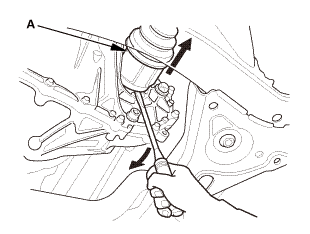
|
|
1.
|
Pry the inboard joint (A) from the differential using a pry bar.
|
|
NOTE:
|
|

|
Do not pull on the driveshaft, or the inboard
joint may come apart.
|
|
|

|
Be careful not to damage the end of the inboard
joint using the pry bar.
|
|
|
|
|
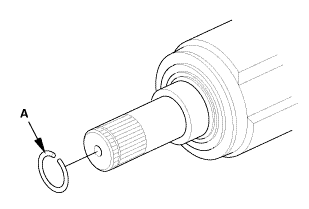
|
|
2.
|
Remove the set ring (A).
|
|
| 7. |
M/T Differential Oil Seal, Left |
|
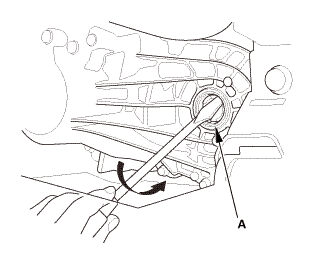
|
|
1.
|
Remove the oil seal (A) using a pry bar.
|
|
NOTE: Be careful not to damage the transmission housing while
removing the oil seal.
|
|

| 1. |
M/T Differential Oil Seal, Left |
|
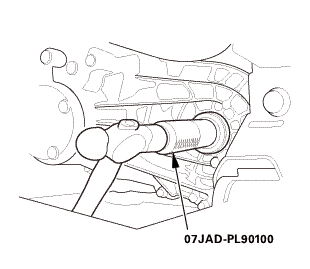
|
|
1.
|
Install the oil seal flush with the transmission housing using
the 65 mm oil seal driver.
|
|
| 2. |
Driveshaft Front Left - Reconnection, Inboard Side |
|
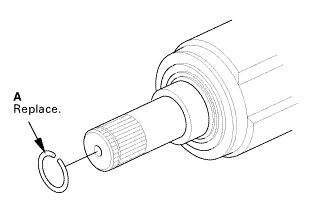
|
|
1.
|
Install a new set ring (A).
|
|
|
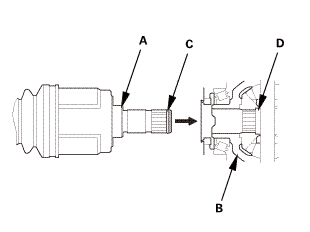
|
|
2.
|
Clean the areas where the driveshaft contacts the differential
thoroughly with solvent.
|
|
NOTE: Do not wash the rubber parts with solvent.
|
|
3.
|
Dry the areas where the driveshaft contacts the differential
thoroughly with compressed air.
|
|
4.
|
Insert the inboard end (A) of the driveshaft into the differential
(B) until the set ring (C) locks in the groove (D).
|
|
NOTE: Insert the driveshaft horizontally to prevent damaging
the oil seal.
|
|
| 3. |
Lower Ball Joint Lower Arm Side - Reconnection |
|
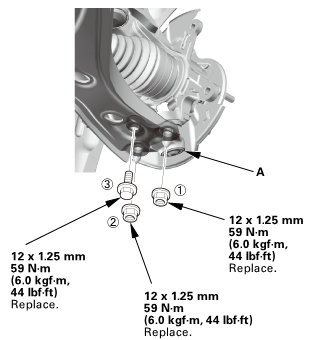 55(ini15mm(skg!m,12x125mm 55(ini15mm(skg!m,12x125mm
|
|
1.
|
Connect the lower ball joint (A) to the lower arm.
|
|
2.
|
Install the new flange nuts and the new flange bolt in the sequence
shown.
|
|
|
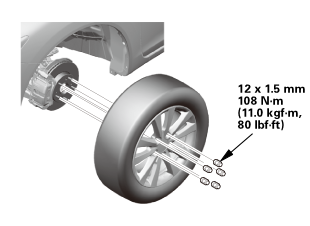 mmmln-mnomm mmmln-mnomm
|
|
1.
|
Install the left front wheel.
|
|
NOTE: Before installing the wheel, clean the mating surfaces
between the brake disc and the inside of the wheel.
|
|
| 5. |
Driveshaft After Install Check |
|
|
1.
|
Turn the wheel by hand, and make sure there is no interference
between the driveshaft and surrounding parts.
|
|
|
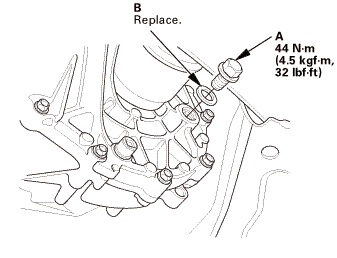
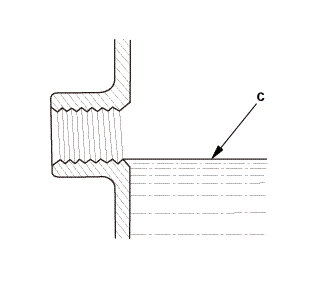
|
|
1.
|
Remove the filler plug (A) and the sealing washer (B).
|
|
2.
|
Refill the transmission with MTF to the proper level (C). Always
use Honda Manual Transmission Fluid (MTF).
|
|
Manual Transmission Fluid Capacity
|
Except K24Z7 engine:
|
| |
1.4 L (1.5 US qt) at fluid change
|
| |
1.6 L (1.7 US qt) at overhaul
|
|
K24Z7 engine:
|
| |
1.9 L (2.0 US qt) at fluid change
|
| |
2.0 L (2.1 US qt) at overhaul
|
|
|
|
|
3.
|
Reinstall the filler plug with a new sealing washer.
|
|
|
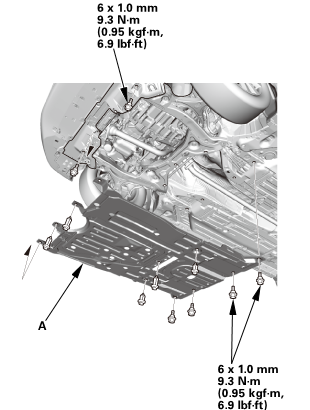
|
|
1.
|
Install the engine undercover (A).
|
|
|
|
For proper inspection and adjustment of the wheel alignment,
do these checks:
|
|
1.
|
Release the parking brake to avoid an incorrect measurement.
|
|
2.
|
Make sure the suspension is not modified.
|
|
3.
|
Make sure the fuel tank is full, and that the tire repair kit,
the spare tire, the jack, and the tools are in place on the vehicle.
|
|
4.
|
Check the tire size and tire pressure according to tire information.
|
|
|
|
Use commercially available computerized four wheel alignment
equipment to measure wheel alignment (caster, camber, toe, and turning
angle). Follow the equipment manufacturer's instructions.
|
|
1.
|
Check the caster angle.
|
|
USA and Canada models
|
Caster angle:
|
| |
Except Si:
|
5 ° 19 ’±30 ’
|
| |
Si (Without 18 inch wheel):
|
5 ° 22 ’±30 ’
|
| |
Si (With 18 inch wheel):
|
5 ° 15 ’±30 ’
|
|
|
|
|
Mexico models
|
Caster angle:
|
| |
Without 18 inch wheel:
|
5 ° 10 ’±30 ’
|
| |
With 18 inch wheel:
|
5 ° 6 ’±30 ’
|
|
|
|
|

|
If the measurement is within specifications,
measure the front camber angle.
|
|
|

|
If the measurement is not within specifications,
check for bent or damaged suspension components.
|
|
|
|
|
|
Use commercially available computerized four wheel alignment
equipment to measure wheel alignment (caster, camber, toe, and turning
angle). Follow the equipment manufacturer's instructions.
|
|
1.
|
Check the camber angle.
|
|
USA and Canada models
|
Camber angle:
|
| |
Except Si:
|
| |
|
Front:
|
0 ° 00 ’±30 ’
|
| |
|
Rear:
|
-0 ° 45 ’±45 ’
|
| |
Si (Without 18 inch wheel):
|
| |
|
Front:
|
-0 ° 04 ’±30 ’
|
| |
|
Rear:
|
-0 ° 52 ’±45 ’
|
| |
Si (With 18 inch wheel):
|
| |
|
Front:
|
-0 ° 18 ’±30 ’
|
| |
|
Rear:
|
-0 ° 45 ’±45 ’
|
|
(Maximum difference between the front right and
left side: 0 ° 45 ’)
|
|
|
|
|
Mexico models
|
Camber angle:
|
| |
Front:
|
0 ° 20 ’±30 ’
|
| |
Rear:
|
-0 ° 22 ’±45 ’
|
|
(Maximum difference between the front right and
left side: 0 ° 45 ’)
|
|
|
|
|

|
If the measurement is within specification, measure
the toe-in.
|
|
|

|
If the measurement for the front camber is not
within the specification, go to front camber adjustment.
|
|
|

|
If the measurement for the rear camber is not
within the specification, check for bent or damaged
suspension components.
|
|
|
|
| 11. |
Front Toe - Inspection |
|
|
Use commercially available computerized four wheel alignment
equipment to measure wheel alignment (caster, camber, toe, and turning
angle). Follow the equipment manufacturer's instructions.
|
|
1.
|
Set the steering column to the middle tilt position and telescopic
positions.
|
|
2.
|
Center the steering wheel spokes, and install a steering wheel
holder tool.
|
|
3.
|
Check the toe with the wheels pointed straight ahead.
|
|
Front toe-in: 0±2 mm (0±0.08 in)
|
|

|
If adjustment is required, go to the front toe
adjustment.
|
|
|

|
If no adjustment is required, remove the alignment
equipment.
|
|
|
|
| 12. |
Turning Angle - Inspection |
|
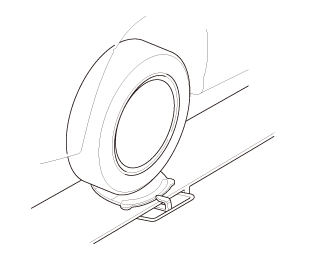
|
|
Use commercially available computerized four wheel alignment
equipment to measure wheel alignment (caster, camber, toe, and turning
angle). Follow the equipment manufacturer's instructions.
|
|
1.
|
Turn the wheel right and left while applying the brake, and measure
the turning angle of both wheels.
|
|
USA and Canada models
|
Turning angle:
|
| |
Except Si:
|
| |
|
Inward:
|
38 ° 30 ’±2 °
|
| |
|
Outward (reference):
|
30 ° 47 ’±1 °
|
| |
Si (Without 18 inch wheel):
|
| |
|
Inward:
|
38 ° 22 ’±2 °
|
| |
|
Outward (reference):
|
30 ° 41 ’±1 °
|
| |
Si (With 18 inch wheel):
|
| |
|
Inward:
|
36 ° 33 ’±2 °
|
| |
|
Outward (reference):
|
29 ° 53 ’±1 °
|
|
|
|
|
Mexico models
|
Turning angle:
|
| |
Without 18 inch wheel:
|
| |
|
Inward:
|
39 ° 12 ’±2 °
|
| |
|
Outward (reference):
|
31 ° 14 ’±1 °
|
| |
With 18 inch wheel:
|
| |
|
Inward:
|
36 ° 58 ’±2 °
|
| |
|
Outward (reference):
|
30 ° 16 ’±1 °
|
|
|
|
|
2.
|
If the measurement is not within the specifications, even up
both sides of the tie-rod threaded section length while adjusting
the front toe.
|
|
3.
|
If it is correct, but the turning angle is not within the specifications,
check for bent or damaged suspension components.
|
|
|

|
|
1.
|
Turn the wheel right and left while applying the brake, and measure
the turning angle of both wheels.
|
|
USA and Canada models
|
Turning angle:
|
| |
Except Si:
|
| |
|
Inward:
|
38 ° 43 ’±2 °
|
| |
|
Outward (reference):
|
30 ° 55 ’±1 °
|
| |
Si:
|
| |
|
Inward:
|
38 ° 36 ’±2 °
|
| |
|
Outward (reference):
|
30 ° 49 ’±1 °
|
|
|
|
|
Mexico models
|
Turning angle:
|
| |
Inward:
|
39 ° 15 ’±2 °
|
| |
Outward (reference):
|
31 ° 21 ’±1 °
|
|
|
|
|
2.
|
If the measurement is not within the specifications, even up
both sides of the tie-rod threaded section length while adjusting
the front toe.
|
|
3.
|
If it is correct, but the turning angle is not within the specifications,
check for bent or damaged suspension components.
|
|
|
|
1.
|
Test-drive the vehicle.
|
|
| 14. |
Maintenance Minder Reset |
|
|
1.
|
After doing all procedures, select the individual maintenance
item you wish to reset with the HDS..
|
|
2131M6 LEFT
1.
Vehicle Lift
1.
Raise the vehicle on a lift, and make sure it is securely supported.
...
2191M0 RIGHT
1.
Vehicle Lift
1.
Raise the vehicle on a lift, and make sure it is securely supported.
...
See also:
Honda Civic Owners Manual. Airbag Care
You do not need to, and should not, perform any maintenance on or replace any
airbag system components yourself. However, you should have your vehicle
inspected by a dealer in the following situations:
When the airbags have deployed
If an airbag has inflated, the control unit and other related p ...


 Left M/T Differential Oil Seal Replacement (K24Z7)
Left M/T Differential Oil Seal Replacement (K24Z7) Right A/T Differential Oil Seal Replacement (A/T)
Right A/T Differential Oil Seal Replacement (A/T)



 i225
i225






 55(ini15mm(skg!m,12x125mm
55(ini15mm(skg!m,12x125mm mmmln-mnomm
mmmln-mnomm


